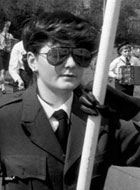
The Road of Women: Voices of Irish Women Political Prisoners 2004
Distributed by Cinema Guild, 115 West 30th Street, Suite 800, New York, NY 10001; 212-685-6242
Produced by Melissa Thompson
Directed by Melissa Thompson
VHS, color, 60 min.
College - Adult
Criminal Justice, Women's Studies, Human Rights, European Studies
Date Entered: 09/09/2005
Reviewed by Shelley A. Myer, University at Buffalo Libraries, State University of New YorkThe Road of Women: Voices of Irish Women Political Prisoners brings us into Northern Ireland in the years following 1971, in which the British government instituted a policy of detention and internment, for which thousands of people in Irish Republican areas were imprisoned. Many of these people were imprisoned without charge or what we in the U.S. would call fair trials. Fifteen thousand Republicans and/or Catholics have been imprisoned since 1971, with a total of more than 100,000 years served. The number of women imprisoned was never counted. Perhaps this was due to thinking that there were few politically active women in British prisons. This was not the case. There were significant numbers of women imprisoned, and many of them were and/or became politically engaged in prison.
This film is the story of some of these women. The viewer meets several former prisoners, who tell of their experiences in prison and their lives after their release. Through them we also learn about the living conditions and issues surrounding the lives of women in the British prisons. The history of the political struggles between Great Britain and Northern Ireland is woven into the film, giving a context to the women’s stories. Finally we are told of one result of imprisonment for many of the women—a greater politicization. Many women left prison more strongly involved in the Republican political movement as a result of their prison experiences.
The scenic direction of the film is quite affecting. Throughout the film, when political dissent is being discussed, the visuals reflect the graffiti on the walls in Northern Ireland, such as “brits out,” and “where there is oppression there is resistance,” and crumbling buildings which show the physical impact of the political conflict. Video clips from some actual events are used effectively to situate the viewer. The incarcerated women’s stories are told against the backdrop of eerie images of the now-closed prisons, accompanied by haunting music.
Opening interviews with several former women prisoners revealing the horrific conditions of prison life. In almost every prison, women often had to write letters on toilet paper. In one prison, the guards kicked over the prisoners’ chamber pots every day, forcing the prisoners to get rid of their waste by smearing it on their walls. Women even had to do this with their menstrual blood. The women were repeatedly strip-searched, hundreds of times during their imprisonment. Their clothes were stripped off their bodies by prison guards, and there were often as many as six to fifteen guards cheering them on. Medical treatment was equally dreadful. One woman recounts her story of a D&C, in which the doctors transported her from the hospital back to the jail within an hour even though she still was sedated and bleeding.
The interviews show that these women were not beaten down by their experiences in prison, however horrible they were. Rather, as one prisoner, Martina Anderson, said, “How, do I, in prison, fight that system, better, more intelligently, and long-term, and come out as strong as possible in the end?” Women in prison fought for prison reforms, both for themselves, and for other prisoners (in one prison, political prisoners were housed with many mentally disabled women whose lives in prison were made worse by their disabilities). Many former prisoners also became strongly involved in the political movement after their release, since they had learned in prison to look at the political situation in more progressive ways. However, there are still ramifications of their imprisonment. One prisoner, Ella O’Dwyer, earned her M.A. and Ph.D. while in prison to deal with the dreadfulness of prison life. When she was finally released from prison, she was offered a job at Boston College, but was unable to get a Visa because of her former imprisonment.
In the late 1980’s and early 1990’s paramilitary violence on each side continued. England continued to refuse Irish prisoners political status and denied them transfer to prisons in Northern Ireland. In 1994, the IRA and Loyalist Paramilitaries called a cease-fire; however, even this did not facilitate the transfer of Irish prisoners. In the fight for transfer, each time a case met the criteria, the criteria would be changed. Although internment was phased out in the 1970’s, the British government continues to detain Irish subjects (without charge) under the prevention of terrorism acts.
This film is highly recommended. It shows the political context of imprisonment in Northern Ireland, and the treatment, and struggle for self-determination, of women prisoners. A small caveat is that a more balanced view of the violence of the Northern Irish Republicans (specifically the IRA) against the British that helped create this culture of imprisonment was largely missing. This film is best for collections strong in criminal justice and political science, as well as for those in women’s studies.